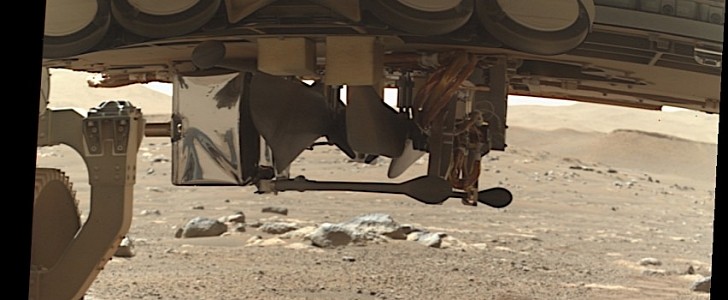It’s called Ingenuity, and it’s a tiny machine sent to the Red Planet piggybacking on the Perseverance rover. Its goal is to power up and spin its blades to prove the Martian atmosphere can support helicopter flight. And here it is, if you can make it out in this image Perseverance took and sent back.
NASA is planning to conduct the flight at a yet unspecified date. It has already chosen the flight zone for Ingenuity, and will reveal more about the plans for the helicopter on March 23. Until then, preparations are underway on Mars, and on Sunday, NASA published the first image of the machine attached to the rover.
The image was captured by Perseverance after the so-called debris shield protecting the helicopter was dropped. If you were expecting to see the thing on the up side of the rover, on a platform of some kind, think again; this thing is attached to the underbelly.
It might be a bit difficult to distinguish what’s going on in this photo, but with NASA’s help, we’ll try to explain. On the Martian ground, we can see the abandoned shield, and to the left, one of the rover’s six wheels. Right in the center of the image, there’s something resembling an insect, its wings folded.
That’s Ingenuity, stowed sideways and locked in place not to fall away from the rover. According to NASA, speaking as if it were Perseverance, “there’s some reverse origami to do before I can set it down.”
The helicopter weighs four pounds (1.8 kg), boasting a fuselage about the size of a softball, and is made from a mix of 1,500 individual pieces of carbon fiber, flight-grade aluminum, silicon, copper, foil, and foam. It will take to the air using twin, counter-rotating blades that will spin at 3,000 rpm.
A successful flight might open the doors to a more in-depth and closer-to-the-target aerial exploration of alien worlds, from altitudes much more revealing than the distant orbit.
The image was captured by Perseverance after the so-called debris shield protecting the helicopter was dropped. If you were expecting to see the thing on the up side of the rover, on a platform of some kind, think again; this thing is attached to the underbelly.
It might be a bit difficult to distinguish what’s going on in this photo, but with NASA’s help, we’ll try to explain. On the Martian ground, we can see the abandoned shield, and to the left, one of the rover’s six wheels. Right in the center of the image, there’s something resembling an insect, its wings folded.
That’s Ingenuity, stowed sideways and locked in place not to fall away from the rover. According to NASA, speaking as if it were Perseverance, “there’s some reverse origami to do before I can set it down.”
The helicopter weighs four pounds (1.8 kg), boasting a fuselage about the size of a softball, and is made from a mix of 1,500 individual pieces of carbon fiber, flight-grade aluminum, silicon, copper, foil, and foam. It will take to the air using twin, counter-rotating blades that will spin at 3,000 rpm.
A successful flight might open the doors to a more in-depth and closer-to-the-target aerial exploration of alien worlds, from altitudes much more revealing than the distant orbit.
Away goes the debris shield, and here’s our first look at the helicopter. It’s stowed sideways, folded up and locked in place, so there’s some reverse origami to do before I can set it down. First though, I’ll be off to the designated “helipad,” a couple days’ drive from here. pic.twitter.com/E9zZGQk5jQ
— NASA's Perseverance Mars Rover (@NASAPersevere) March 21, 2021

